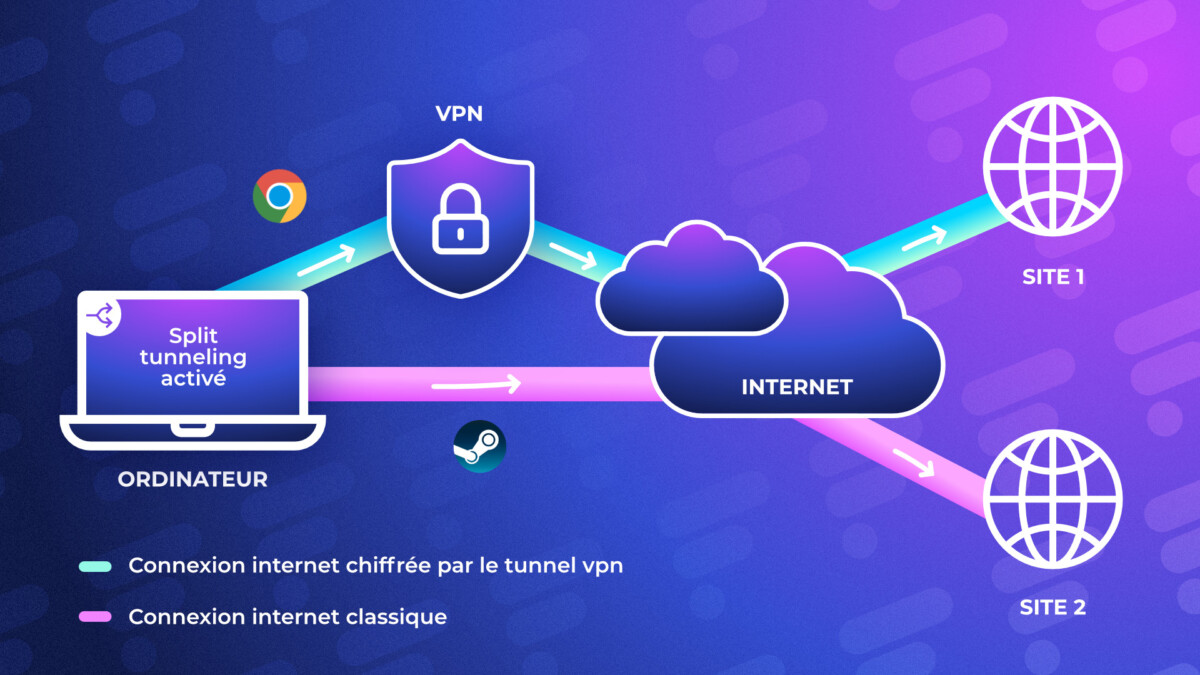Within a VPN application, split tunneling is a feature that allows the user to choose which applications (or websites) should go through the VPN tunnel and which should go through your regular internet connection. A good solution to distribute the bandwidth according to the content and the greediness of your activities. Here’s everything you need to know about split tunneling.
The advantages of a VPN are numerous: protection of personal data while browsing, circumvention of the geoblocking implemented by certain governments or even anonymization of the user during his passage on the Net.
VPNs can also help manage bandwidth better. For this, it relies on a very simple technology: split tunneling. We explain how it works.
Split tunneling, what is it?
When you activate a VPN, it creates a digital tunnel between the device and the VPN server. Thus, all incoming and outgoing data passes through this tunnel to be encrypted, before being redirected by the VPN server to the desired destination.
However, this tunnel sometimes has the annoying tendency to slow down the speed or latency of the connection. Similarly, some sites or applications detect the use of a VPN and deny access to services.

This is where split tunneling comes in. This feature allows the user to choose which connections are protected by a VPN and which connections travel over the Internet without additional security.
Three types of split tunneling exist:
- Reverse split tunneling: when this option is enabled then all traffic goes through the VPN by default. The user must determine the trusted sites and apps that do not need to be encrypted;
- split tunneling by application: here, by default, no connection goes through the VPN. The user must indicate which ones should benefit from the protection of the VPN (torrent client, Netflix);
- split tunneling by URL: Here too, all connections are managed by the VPN. The difference is that the user must specify the URLs of the sites to exclude them from the VPN.
Formerly not very present in VPN applications, the option is now implemented in the best VPNs such as Surfshark, NordVPN, PureVPN or ExpressVPN.
What uses for split tunneling?
The main advantage of split tunneling is to better distribute the connections and thus not to clutter the VPN’s digital tunnel. Downloading a game from Steam, for example, is extremely resource-intensive and doesn’t need to go through a VPN. It is therefore interesting to exclude it from protection thanks to split tunneling, while keeping the VPN active for web browsing. The latter being less slowed down by the number of incoming and outgoing data passing through the digital tunnel.
This is also the main interest of reverse split tunneling and split tunneling by URL: keep your VPN protection constantly active, except for a few exceptions.
Conversely, per-app split tunneling is more useful for those who only need a VPN for one or two activities, such as downloading torrents, or viewing a site or geoblocked service.
Split tunneling in a VPN also allows you to keep control of your local network. Some devices connected to your computer can stick out their tongue if they detect a VPN (we think of a printer connected to a network). Split tunneling offers a way to bypass blocking without having to turn off the VPN each time.
Disadvantages of split tunneling
Split tunneling is not without flaws. Its configuration requires some knowledge of network management and a bad configuration can potentially lead to a data leak.
Similarly, within a company, split tunneling can be used to circumvent security protocols and restrictions put in place by the IT department.
Finally, split tunneling does not work with all devices. Machines running Windows or Android have a rather open operating system, and can therefore accommodate split tunneling without worry. On the other hand, devices based on Apple’s OS operate in a more closed environment. That’s why many VPNs don’t offer split tunneling on iPhones, iPads, and Macs.
Do you use Google News (News in France)? You can follow your favorite media. Follow Frandroid on Google News (and Numerama).
